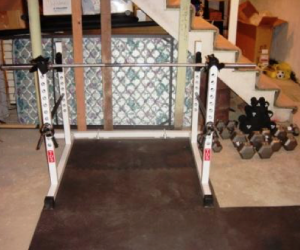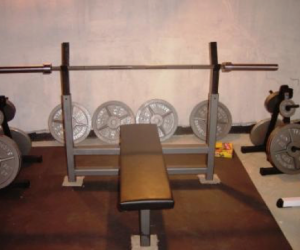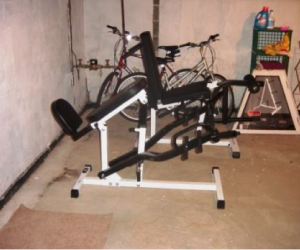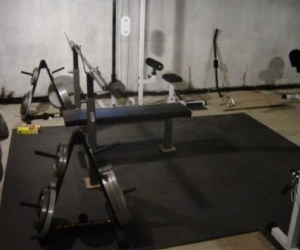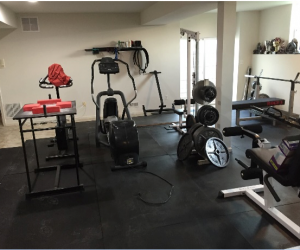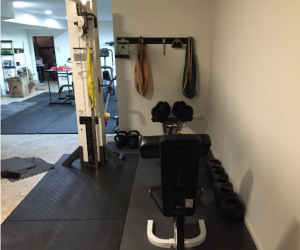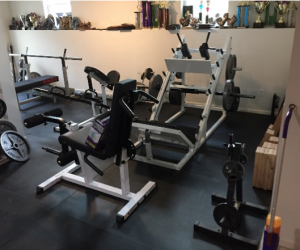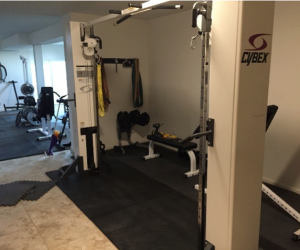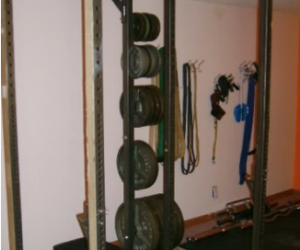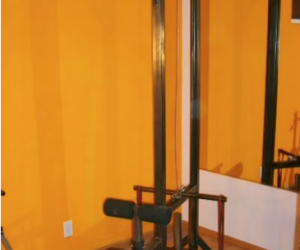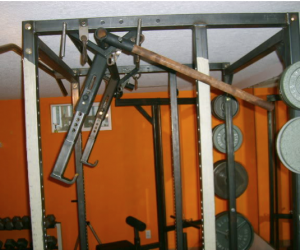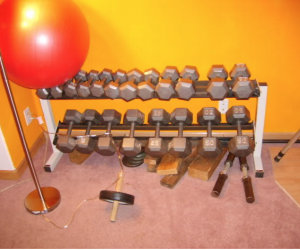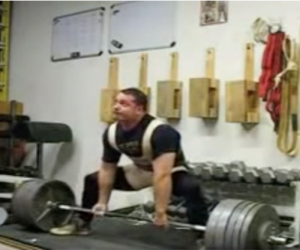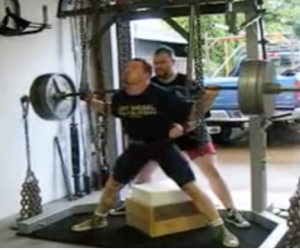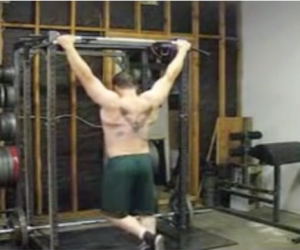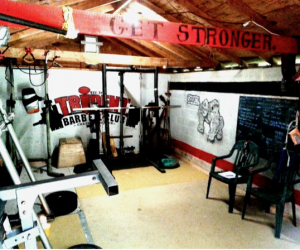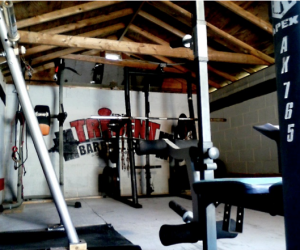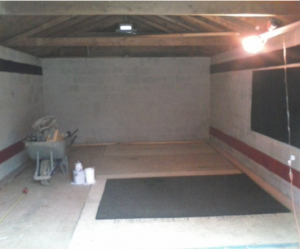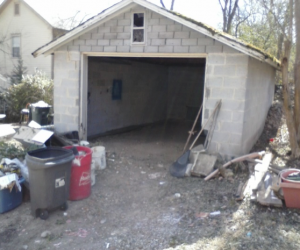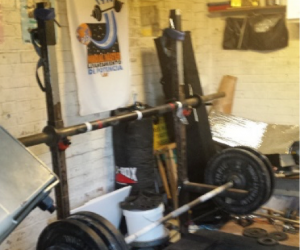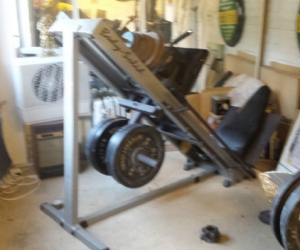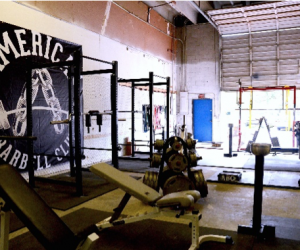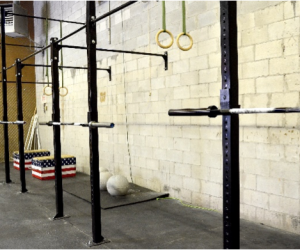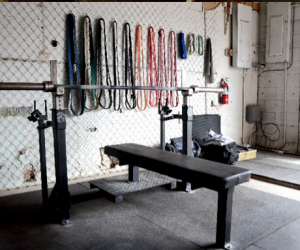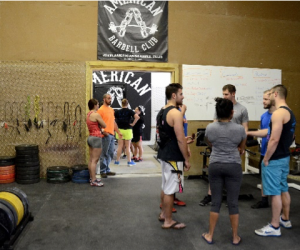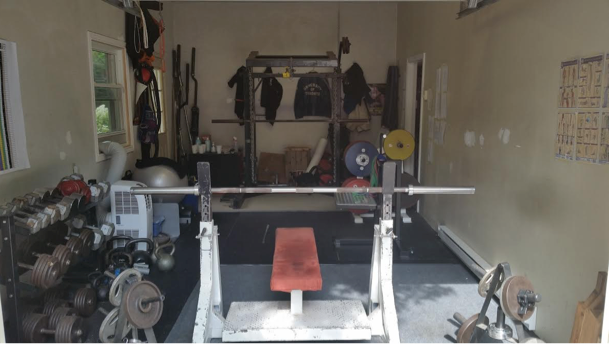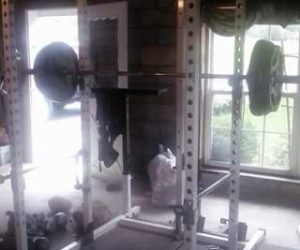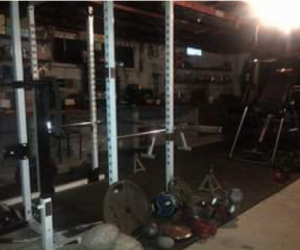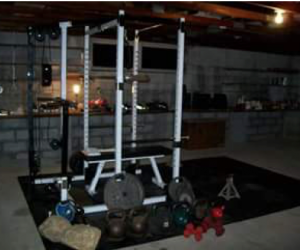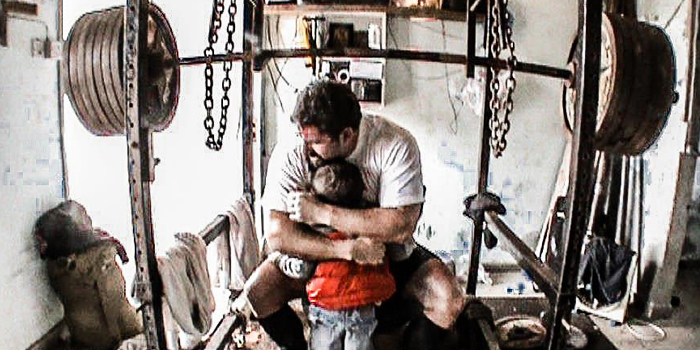
In part one we discussed how commercial gyms could become home-like environments. From now on, we will follow the evolution of home gyms, which start the other way around: people make their homes—or rather, parts of their homes—into their gym. Nine athletes and coaches who own or owned home gyms were asked to answer a general questionnaire and, according to the evolution of their early setup (either into a barbell club, a commercial facility or both, sequentially), two specific questionnaires. These people are Bruce McIntyre, Chris Duffin, Harry Selkow, Shawn Lattimer, Jack Kottwitz, John Hollier, Tom Barrett, Robb Mantovani, and Andrew Kuttner. Bruce is from Canada and Andrew is from England. The rest of the interviewees are American.
Why do people set up private and personal gyms in their homes?
The reasons given by the interviewees for starting their home gyms fall into the following classes:
1. Insufficient or Inadequate Training Equipment at Local Commercial Gyms
“I needed to use a monolift for training for competitions and no commercial gym would let me put one in their gym.” —Bruce McIntyer
“Upon moving back to Florida after the military, I made it a priority to find a powerlifting gym. And not surprisingly, Gainesville didn’t have one.” —John Hollier
“Our local sports centre removed the “heavy” free weights, squat racks, etc., from its gym, turning it into a fitness gym” —Andrew Kuttner
2. Convenience (Time and Commuting Constraints)
“Convenience” —Harry Selkow
“Then later after a divorce and a remarriage, it was my time constraints. It was the only way I could make sure to have the time to do it.” —Tom Barrett
3. Inadequate Social Environment at Local Commercial Gyms in General
“My needs were not met at normal gyms and most gyms didn’t want me.” —Chris Duffin
“Gyms didn’t like powerlifters training there. I was blackballed by multiple gyms” —Shawn Lattimer
“The local gym was not powerlifting-friendly” —Robb Mantovani
If any interviewee failed to spell out the social inadequacy of local commercial gyms as a reason for setting up their home gym, that aspect became clear in other parts of the interview, especially in the “pros and cons” question.
Basic Facts and Conclusions from Our Interviewees’ Experience
Most of the home gyms were built in the early to mid-2000s, two are from the mid 1990s, one earlier than that, and two started recently, in the last three years. The fact that, except for two, all these home gyms are over 10 years old qualifies the accounts as relevant to understand successful attempts at building and maintaining home gyms. It also allows us to track the transformations that they undergo.
Because they were selected among my close contacts, all the interviewees have a relationship with powerlifting, were, or are powerlifters. Powerlifters are an interesting sub-set of practitioners to study home gym dynamics for two reasons: First, it is easier to build a powerlifting gym in a domestic environment and, second, because powerlifting, as a set of movements and techniques, can be seen as a strength training foundation.
Part 1: Home and the Home Gym — The Roots
Consistent with other personal accounts and those we can pick up on the Internet, the preferred spaces among the interviewees for home gyms are the garage and the basement, although we have outside areas (Robb Mantovani) and even a bedroom (Jack Kottwitz).
As for how much building effort and skill are needed, among my interviewees I have extremes: from hors concours Chris Duffin, who can basically build anything he sets his mind to, to people who admit they have no skill and will either buy or have the equipment custom-made for them. Between one and the other, most people had to learn to build at least something.
“I’ve had a home gym of some sort since I first started lifting weights. The very first gym I had, I couldn’t afford a metal power rack, so I built one out of old railroad ties” —Jack Kottwitz
“Nope, I have four thumbs.” —Bruce McIntyre
“Over the years I built a few things. Had to learn to weld.” —Shawn Lattimer
“Yes! I’m a terrible carpenter/builder but the equipment I built is still in use! It was not difficult…I just designed them based on logic and trial and error.” —Robb Mantovani
That is good news: building skills will save money, but it is not an impediment for having your home gym.
As for initial equipment, among the interviewees we had everything between a bench rack to a fully equipped training environment with monolift:
“Monolift, competition bench, plates, cambered bar, safety squat bar, competition squat bar, competition deadlift bar and bench bar. Started with pound plates and dumbbells. Had a power rack as well and a jumping platform, a box squat platform, sleds and boxing equipment. Lots of bands and one set of chains.” —Bruce McIntyre
“Started with a squat rack, deadlift platform, flat bench to be used on squat rack, GHR, and a low/high plate loaded cable machine. Bars, plates, and dumbbells” —Chris Duffin
“All elitefts equipment. 3x3 Power Rack, GHR, Reverse Hyper, chest-supported row, lat pulldown, dumbbells from five to 100 pounds, bench, bars and a ton of weight” —Harry Selkow
“Started with a bench, bar, plates, rack, and a lat machine” —Shawn Lattimer
“We already had a squat rack and bench that was located on our front porch of the house which we used for our training. We acquired dumbbells and more weight plates as we got stronger.” —Robb Mantovani
In one case, all equipment was bought new (Harry Selkow) and in another it was all built by the owner (Chris Duffin). All the others fall somewhere between buying part used, part new, and building some.
Those who could offer an estimate of expenses until they had a configuration they were satisfied with to start training ranged from $2,500 to $10,000. Some had no idea, having built part of the equipment themselves, obtained items as gifts, client payment, etc.
The most important conclusion from the first questionnaire is that owners are unanimously happy about their gyms. The benefits listed range from emotional (freedom to train whenever one wants, with whichever music one chooses and dressed in whatever clothes one has on, meaning control, privacy, and territory) to improved competitive performance and training quality.
Home Gym, Family, Substitute/Alternative Family, and Personal Space
Although there is no quantitative study on the matter, home gyms and gyms with a home-like environment seem to be much more common in the USA than in any other country. The by-proxy indicator for that is the source of information for home gym construction and home gym websites, all of which are American-based.
Successful home gyms in the USA tend to become the locus for small communities (Wellman and Gulia 1996, Wellman and Frank 2001), whereas the few I personally knew in other countries, including my own, remained a single-person training setting. Barbell clubs are rare, CrossFit boxes being the closest there is to them in many countries.
There are several possible causes for that. The first and most relevant one for the purpose of this series is that strength training tends to be a meaningful activity here more than anywhere else, with the exception of Eastern European countries where it is less of a personal issue than a social-professional one, with strong state and government support. It is the constitution of an activity as meaningful that determines the requirements for a personal environment, territory and home-like structure.
The other possible cause is related to the American family structure and internal mobility (Martin & Charles-Edwards 2014, Bell et al 2015, Fisher 2002). Unlike post-feudal societies, such as major European ones, American adults will rarely live and die where their consanguineous family reside. Adults move, from a young age, according to academic and occupational reasons. This dynamic physically (if not emotionally as well) separates people from their biological families and compels them to find relevant social support elsewhere: churches, neighborhoods, and sports, for example. Gyms that are home-like, as home gyms proper, can actually be family substitutes.
The home gym not only renders itself as the locus for the growth of small, family-like communities, but also usually starts and evolves in harmony with the owner’s family dynamic. The successful ones are those that integrate immediate family members in the home gym endeavor, especially the spouse:
“We commonly refer to it as Julie’s gym. She’s my wife and puts up with the invasions.” —Bruce McIntyre, in a question about the name of the home gym.
“My fiancé and I used the space to train for powerlifting.” —Robb Mantovani, in a question about who else used the gym.
“I trained my wife, family, friends, private clients, a few local athletes, and a few local celebrities.” —Harry Selkow, same question.
“We had a powerlifting team consisting of six members consistently, sometimes as many as 12. All friends, sometimes my wife trained also.” —Shawn Lattimer
The constitution of family-like bonds between frequent guests (or members) is explicit in some interviews, such as:
“Cons: I have to vacuum and spend hours fixing and cleaning! Pros: We have a great family of athletes, we can play whatever music as loud as we want, are open always, there is always someone to train with, our training evolves rapidly (a few club members are also coaches), scheduling is never a problem, the gym focus is to train so there aren’t many distractions, and I can wear my really, really short shorts to squat in without having a Globo Gym manager tell me to put more clothes on!” —Robb Mantovani, about the pros and cons of a home gym.
Sometimes it is explained away because of “our style of training”:
“The first one was me…just me. Currently, I have an open-door policy. If you are a competitive lifter and need a place to train, let me know. I have few rules: help each other get stronger, respect the equipment and the people in the gym, if you break it you buy it before you leave, loud music and profanity is fine, and don’t waste chalk. You have one goal: walk out with a PR or a little more knowledge so you are a better lifter.” —Jack Kottwitz, about who used the gym.
MORE: Why My Home Gym Is Better Than the S4 Compound
“There have been about 200 people through the gym. Most have been people interested in powerlifting. We train hard so we have a fairly high drop-off rate. There have been several different groups over the past decade. We have a core of about eight people and another 10 or so in each wave.” —Bruce McIntyre, same question.
Although it is true that what originally brings together the members of the small community of guests at a home gym is their common interest in a certain type of training, that type of training and its relation to the sport constitute identity descriptors for these people. It is a core of their sense of belonging and being.
Evolution of Home Gyms within the Configuration of a Home Gym Proper[i]
From the three clusters of reasons listed above (inadequacy of equipment in commercial gyms, convenience, social inadequacy of local commercial gyms), home gyms start with the set of equipment items the owner is content with to begin his training. How they evolve in terms of training practices and equipment involved reflects the owner’s personal trajectory in the sport or the training world. There is no rule or “best way.” By definition, a home gym is a reflection of its owners’ goals, motivation, hopes, and other very individual traits.
“It doubled in size, and over the last eight years, it has evolved from powerlifting to arm-wrestling oriented. Now no more power rack but lots of fat grips and biceps-related tools” —Shawn Lattimer, answering a question about his home gym evolution.
“It has been more an evolution of training techniques. We try and change training styles frequently to avoid staleness” —Bruce McIntyre, same question.
Starting A Home Gym 1: Space
Home gyms can be set up in very small places. Anywhere you can fit a power rack, with enough space to load the weights in the bar, insert and take away a regular flat bench from inside it, and keep your bar, plates, and bench is enough.
It is tight, but you can start a home gym with about 60 square feet of free space. I didn’t have much more than that for mine.
An average garage for two cars is 400 square feet in area. I’ve been to powerlifting training centers that were smaller than this or this size and I saw eight people training together, at the same time. So yes: where there is a will, there is a way.
Starting A Home Gym 2: Equipment
Based on my interviewees' experience, random accounts on the Internet, my own home gym, and assisting others with equipment choice, I created two formats. The quotes were obtained from the elitefts website for new equipment.
Basic Equipment — Compact
- Power Cage: $829, Garage Line 3x3 Power Rack w/ Weight Storage
- Olympic Bar: $356.15, 2200 mm Men's elite Power Bary (20kg)
- 798-pound Plate Set: $1,049.72, York Standard Uncalibrated (20kg)
- Flat Bench: $179, Garage Line DB Flat Bench
- Collars: $8
- Total: $2421.87
Basic Equipment — Medium Size
- Power Cage: $829, Garage Line 3x3 Power Rack w/ Weight Storage
- Bench Rack: $675, Heavy Duty Deluxe Competition Bench
- (2) Olympic Bars: $712.3, 2200mm Men's Elite Power Bar (20kg)
- Flat Bench: $179, Garage Line DB Flat Bench
- Collars: $8
- Total: $4268.3
The first (compact) configuration fits small areas. With a small three-feet by eight-feet deadlift platform and an additional bar, two small groups of up to three lifters may train together, given that one is going light and one heavier, one is squatting or benching, and the other is deadlifting. Otherwise it is a “single group” configuration. The second one (medium size) allows for two small groups to train at the same time.
Floor: With some common sense and very cheap material, you can equip your home gym with efficient and foundation-sparing cover. A one-inch plywood layer covered with some sturdy rubber material will do. Good options are horse stall mats and other rubber flooring materials such as those made with recycled tires.
Several other items may be relevant for an “initial configuration” for your home gym, depending on your training style and choices. Obvious ones are:
Others, usually useful in strength training in general include:
- Straps and Ropes
- Links (to attach stuff to stuff)
- Boxes (for box squatting or for anything else you may want to use the boxes for)
- Kettlebells
I can assure you that the first basic configuration alone is enough for pretty good training; that was my first configuration when I prepared for my best meets, one of which gave me the all-time classic squat record.
Starting A Home Gym 3: Maintenance and Use
You will be amazed at how many people you can fit in a minuscule space with basic equipment and still train hard and well. The power cage should allow you to train alone for almost anything. It is my stand, however, that it is not wise to do heavy squats or benching alone. Dave Tate has covered the most important points about why not to train alone in his article, "Why Powerlifters Shouldn't Train Alone."
All the basic material listed above and some of the extra equipment suggested doesn’t require a lot of maintenance.
Starting A Home Gym 4: Costs
You can start a basic home gym with anything between $1,000 and $3,000. That is about $100/month for two years. If you add gym membership, commuting costs and others, you will see your home gym pays for itself in a short time.
In the next parts of this series, we will explore the possible paths the evolution of a home gym may take: becoming a barbell club, a commercial facility, or something in between.
Acknowledgments: Bruce McIntyre, Chris Duffin (http://www.kabukistrength.com/), Harry Selkow, Shawn Lattimer, Jack Kottwitz, John Hollier (http://www.abcstrong.com/), Tom Barrett, Robb Mantovani and Elisha Santucci (https://tridentbarbellclub.com/) and Andrew Kuttner.
Images from the First Configurations of Our Interviewees’ Home Gyms
Shawn Lattimer — First House
Shawn Lattimer — Second House
Chris Duffin — First Configuration
Chris Duffin — Second Configuration
Robb Mantovani — First Configuration
Andrew Kuttner
John Hollier (American Barbell Club) —First Configuration
Bruce McIntyre
Tom Barrett
References
- Bell, Martin, and Elin Charles-Edwards. Measuring internal migration around the globe: a comparative analysis. No. 3. 2014.
- Bell, Martin, et al. "Internal migration and development: comparing migration intensities around the world." Population and Development Review 41.1 (2015): 33-58.
- Fischer, Claude S. "Ever‐more rooted Americans." City & Community 1.2 (2002): 177-198.
- Tate, D. Why Powerlifters Shouldn't Train Alone. From https://www.elitefts.com/education/why-powerlifters-shouldnt-train-alone/ 2016. Retrieved in December 2016.
- Wellman, Barry, and Kenneth Frank. "Network capital in a multilevel world: Getting support from personal communities." Social capital: Theory and research (2001): 233-273.
- Wellman, Barry, and Milena Gulia. "Where does social support come from? The social network basis of interpersonal resources for coping with stress." Social Conditions, Stress, Resources and Health. 1996.
[i] The next parts (articles) will explore the evolution of home gyms into different configurations, or their transformations into things other than home gyms.










